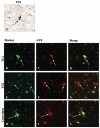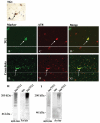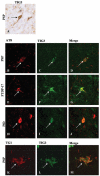Transglutaminase 1 and its regulator tazarotene-induced gene 3 localize to neuronal tau inclusions in tauopathies
- PMID: 22009441
- PMCID: PMC4756648
- DOI: 10.1002/path.2984
Transglutaminase 1 and its regulator tazarotene-induced gene 3 localize to neuronal tau inclusions in tauopathies
Abstract
Alzheimer's disease (AD), progressive supranuclear palsy (PSP), frontotemporal dementia and parkinsonism linked to chromosome 17 (FTDP-17), and Pick's disease (PiD) are commonly known as tauopathies. Neurodegeneration observed in these diseases is linked to neuronal fibrillary hyperphosphorylated tau protein inclusions. Transglutaminases (TGs) are inducible enzymes, capable of modifying conformational and/or structural properties of proteins by inducing molecular cross-links. Both transglutaminase 1 (TG1) and transglutaminase 2 (TG2) are abundantly expressed in the brain and are associated with fibrillary hyperphosphorylated tau protein inclusions in neurons of AD, so-called neurofibrillary tangles (NFTs). However, other data obtained by our group suggested that tau pathology in the brain may be primarily related to TG1 and not to TG2 activity. To obtain more information on this issue, we set out to investigate the association of TG1, TG2, and TG-catalysed cross-links with fibrillary hyperphosphorylated tau inclusions in tauopathies other than AD, using immunohistochemistry. We found strong TG1 and TG-catalysed cross-link staining in neuronal tau inclusions characteristic of PSP, FTDP-17 with mutations in the tau gene (FTDP-17T), and PiD brain, whereas, in contrast to AD, TG2 was only rarely observed in these inclusions. Furthermore, using a biochemical approach, we demonstrated that tau is a substrate for TG1-mediated cross-linking. Interestingly, we found co-localization of the TG1 activator, tazarotene-induced gene 3 (TIG3), in the neuronal tau inclusions of PSP, FTDP-17T, and PiD, but not in NFTs of AD cases, indicating that these tau-containing protein aggregates are not identical. We conclude that TG1-catalysed cross-linking, regulated by TIG3, might play an important role in the formation of neuronal tau inclusions in PSP, FTDP-17T, and PiD brain.
Copyright © 2011 Pathological Society of Great Britain and Ireland. Published by John Wiley & Sons, Ltd.
Figures





Similar articles
-
Cellular tau pathology and immunohistochemical study of tau isoforms in sporadic tauopathies.Neuropathology. 2006 Oct;26(5):457-70. doi: 10.1111/j.1440-1789.2006.00743.x. Neuropathology. 2006. PMID: 17080726
-
Transglutaminases and transglutaminase-catalyzed cross-links colocalize with the pathological lesions in Alzheimer's disease brain.Brain Pathol. 2009 Oct;19(4):612-22. doi: 10.1111/j.1750-3639.2008.00197.x. Epub 2008 Jul 31. Brain Pathol. 2009. PMID: 18673368 Free PMC article.
-
Pathological inclusion bodies in tauopathies contain distinct complements of tau with three or four microtubule-binding repeat domains as demonstrated by new specific monoclonal antibodies.Neuropathol Appl Neurobiol. 2003 Jun;29(3):288-302. doi: 10.1046/j.1365-2990.2003.00463.x. Neuropathol Appl Neurobiol. 2003. PMID: 12787326
-
[Neuropathology of tauopathy].Brain Nerve. 2013 Dec;65(12):1445-58. Brain Nerve. 2013. PMID: 24323931 Review. Japanese.
-
Structure of NFT: Biochemical Approach.Adv Exp Med Biol. 2019;1184:23-34. doi: 10.1007/978-981-32-9358-8_2. Adv Exp Med Biol. 2019. PMID: 32096025 Review.
Cited by
-
Cellular factors modulating the mechanism of tau protein aggregation.Cell Mol Life Sci. 2015 May;72(10):1863-79. doi: 10.1007/s00018-015-1839-9. Epub 2015 Feb 11. Cell Mol Life Sci. 2015. PMID: 25666877 Free PMC article. Review.
-
TIG3: an important regulator of keratinocyte proliferation and survival.J Invest Dermatol. 2014 Jul;134(7):1811-1816. doi: 10.1038/jid.2014.79. Epub 2014 Mar 6. J Invest Dermatol. 2014. PMID: 24599174 Free PMC article. Review.
-
Tissue Transglutaminase and Its Product Isopeptide Are Increased in Alzheimer's Disease and APPswe/PS1dE9 Double Transgenic Mice Brains.Mol Neurobiol. 2016 Oct;53(8):5066-78. doi: 10.1007/s12035-015-9413-x. Epub 2015 Sep 19. Mol Neurobiol. 2016. PMID: 26386840 Free PMC article.
-
Transglutaminase is a therapeutic target for oxidative stress, excitotoxicity and stroke: a new epigenetic kid on the CNS block.J Cereb Blood Flow Metab. 2013 Jun;33(6):809-18. doi: 10.1038/jcbfm.2013.53. Epub 2013 Apr 10. J Cereb Blood Flow Metab. 2013. PMID: 23571278 Free PMC article. Review.
-
Transglutaminase 1: Emerging Functions beyond Skin.Int J Mol Sci. 2024 Sep 25;25(19):10306. doi: 10.3390/ijms251910306. Int J Mol Sci. 2024. PMID: 39408635 Free PMC article. Review.
References
-
- Brion JP, Flament-Durand J, Dustin P. Alzheimer’s disease and tau proteins. Lancet. 1986;2:1098. - PubMed
-
- Grundke-Iqbal I, Iqbal K, Quinlan M, et al. Microtubule-associated protein tau. A component of Alzheimer paired helical filaments. J Biol Chem. 1986;261:6084–9. - PubMed
-
- Mandelkow EM, Mandelkow E. Tau in Alzheimer’s disease. Trends Cell Biol. 1998;8:425–7. - PubMed
-
- Nukina N, Ihara Y. One of the antigenic determinants of paired helical filaments is related to tau protein. J Biochem. 1986;99:1541–4. - PubMed
-
- Yoshida M. Cellular tau pathology and immunohistochemical study of tau isoforms in sporadic tauopathies. Neuropathology. 2006;26:457–70. - PubMed
Publication types
MeSH terms
Substances
Grants and funding
LinkOut - more resources
Full Text Sources
Miscellaneous

